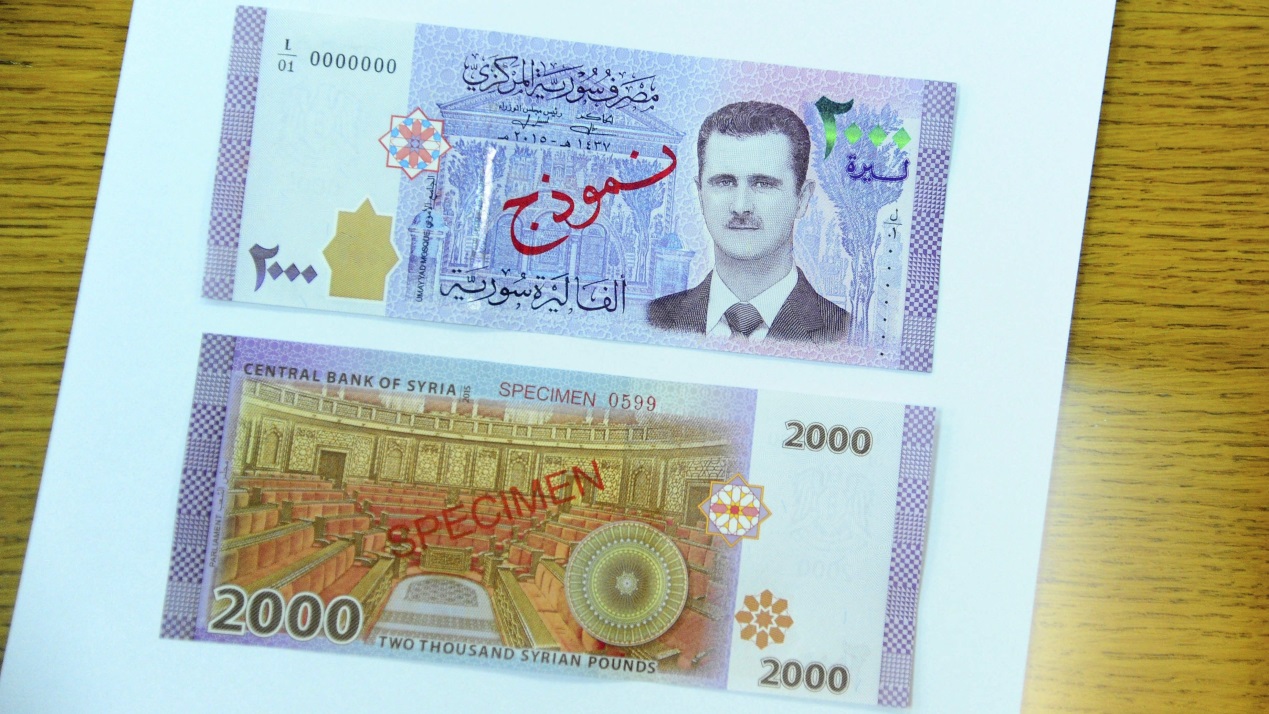Quartz
No matter what they think of Bashar al-Assad, Syrians are used to seeing his face—the country has been plastered with billboards of the embattled president since the 2000s, and that of his father for decades longer. Over a seven-year civil war, plenty of protestors have also taken the liberty of tearing down or defacing his likeness. But with a new Syrian banknote, they’ll find it hard to destroy him in effigy without also hitting themselves in the pocket.
For the first time since he took office in 2000, the Syrian president is joining some of the world’s most infamous dictators in putting his own face on his country’s currency. The 2,000 Syrian Lira note, worth around $4, will go into circulation on Sunday (July 8), because the notes currently circulating in the war-torn country have suffered too much “wear and tear” according to Syria’s Central Bank governor. It’s not just the notes themselves that have been hit; the currency’s value has plummeted from 47 Syrian pounds to the dollar before the war started in 2011 to more than 500 pounds to the dollar this year, according to the AP.
Branding yourself on money was a trick beloved by Benito Mussolini, Saddam Hussein, Ferdinand Marcos, Idi Amin, and Francisco Franco among others. But while Mussolini and Amin were fond of portraying themselves in military get-up, and former Iranian supreme leader ayatollah Khomeini accentuated his religious credentials, Assad’s portrait is very much in line with the image he has been cultivating since taking power at the age of 34: a secular, modernizing leader, ostensibly prepared to put the country through much-needed reforms.
On the new bill, Assad is wearing one of the beloved sleek suits that made him seem dynamic at home and approachable in the West. His face is free of the creases of age and stress that have marked it in his 17 years in power, and he bears the trademark moustache worn during those younger years but abandoned of late. The tension between the promise of secular democracy and a commitment to Islam is born out in the buildings depicted on the note. His face is placed next to the Umayyad mosque in Damascus—one of the world’s oldest Muslim holy sites—and balanced out with the image of Syria’s parliament on the other side of the bill.
Assad’s opponents will be quick to see the irony in his claiming this picture of parliament as symbolizing love of democracy: the parliamentary chamber shown is empty, lacking any elected politicians to govern it.
Three Syrian soldiers walk in front of a billboard showing Syrian President Bashar Assad with an Arabic sentence reading:
"Syria is protected by God," in Damascus, Syria, Wednesday Sept. 13, 2006. The rapid response by Syrians guarding the US embassy won rare praise from the United States, which accuses President Bashar Assad's government of supporting terrorism in its backing of Hezbollah guerrillas and Palestinian militants. Secretary of State Condoleezza Rice said, "I do think that the Syrians reacted to this attack in a way that helped to secure our people, and we very much appreciate that."(AP Photo/Hussein Malla)
As far as lofty cult of personality gambits go, putting yourself on a banknote pales in comparison with some of Assad’s predecessors, however. Consider the construction of Ferdinand Marcos’ mountain bust 140 miles north of Manila, which required displacing an entire tribal village. After the Filipino dictator was deposed in 1986, the new government chose to keep his massive sculpture as a “symbol of injustice.” Marcos’ opponents eventually found revenge when an unknown group blasted the statue in 2002.
Philippine presidential candidate and former first lady Imelda Marcos lays flowers at the foot of the giant bust of her late husband, former Philippine President Ferdinand Marcos, during her first visit to the monument in Mount Pugo, Philippines, April 19, 1992. The statue was put up in the early 1980?s. Imelda said she did not know the statue existed until she learned about it during her exile in 1986.
Taking over a mountain is peanuts compared to the self-aggrandizing moves of former Turkmenistan president Saparmurat Niyazov. Niyazov, who called himself “Turkmenbashi” (translation: Head of all Turkmen People), named months and days of the week after his relatives, and erected a solid gold statue of himself in the capital Ashgabat. The statue rotates to follow the sun.
In this photo taken on June 14, 2009, a 12-meter (40-foot) gold-leaf statue of late Turkmenistan's President Saparmurat Niyazov stands on a 75-meter (246-foot) pedestal in the Turkmen capital Ahgabad. Niyazov's figure turns to face the sun during the day, gleaming brightly in the desert sun. At night it is bathed in colored floodlights, visible for kilometers (miles) in every direction.
Meanwhile, Nursultan Nazarbayev, Kazakhstan’s president since independence from the Soviet Union in 1991, has a meta-spin on banknote portraiture. A close look at his country’s currency reveals Bayterek tower, a skyscraper in Astana with no practical function at all. All you can do in it is take an elevator to the golden orb at the very top, see views of the boundless steppe and approach a plinth with a gold sculpture of Nazarbayev’s handprint. When VIP visitors come to the tower and put their hand in Nazarbayev’s print, the Kazakh national anthem trumpets out.

